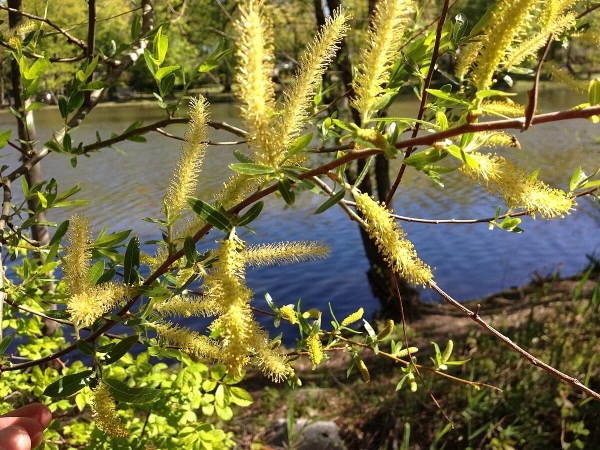
Black Willow
Botanical Name
:
Salix nigra
Plant Type
:
Deciduous shrub
Seasons
:
Plant in spring; blooms in mid to late spring
Sun Level
:
Full sun to partial shade
Ideal Soil Temperature for Planting
:
50–70°F (10–21°C)
Soil Type
:
Moist, well-draining soil; thrives in loamy, sandy, or clay soil
Hardiness Zones
:
4–8 (USDA)
Germination
:
Seeds germinate quickly, often within 24 hours in moist conditions
P.H. Level
:
Slightly acidic to neutral (5.5–7.5)
Water/Irrigation
:
Prefers wet or consistently moist soil
Fertilization
:
Generally not required, but benefits from compost or balanced fertilizer in poor soils
Habit
:
Fast-growing, irregular shape with spreading branches
Propagation
:
Easily propagated by cuttings. Also by seed, though less common
Final Plant Height
:
30–60 ft
Spread
:
15–30 ft
Flowers
:
Small, yellowish-green catkins appearing in early spring
Attracts
:
Pollinators like bees and butterflies; provides habitat for birds and small mammals
Uses
:
Erosion control, streambank stabilization, shade tree, basket weaving, traditional medicine
Companions
:
Red maple (Acer rubrum), swamp milkweed (Asclepias incarnata), and buttonbush (Cephalanthus occidentalis)
Pruning
:
Best pruned in late winter or early spring to remove dead or damaged branches
Toxicity
:
Non-toxic to humans and pets
Pests
:
Susceptible to aphids, scale insects, and borers
Diseases
:
Can be affected by willow blight, powdery mildew, and cankers
Fun Fact
:
The bark of Black Willow contains salicin, a natural compound that was historically used to make aspirin
Botanical Name
:
Salix nigra
Plant Type
:
Deciduous shrub
Seasons
:
Plant in spring; blooms in mid to late spring
Sun Level
:
Full sun to partial shade
Ideal Soil Temperature for Planting
:
50–70°F (10–21°C)
Soil Type
:
Moist, well-draining soil; thrives in loamy, sandy, or clay soil
Hardiness Zones
:
4–8 (USDA)
Germination
:
Seeds germinate quickly, often within 24 hours in moist conditions
P.H. Level
:
Slightly acidic to neutral (5.5–7.5)
Water/Irrigation
:
Prefers wet or consistently moist soil
Fertilization
:
Generally not required, but benefits from compost or balanced fertilizer in poor soils
Habit
:
Fast-growing, irregular shape with spreading branches
Propagation
:
Easily propagated by cuttings. Also by seed, though less common
Final Plant Height
:
30–60 ft
Spread
:
15–30 ft
Flowers
:
Small, yellowish-green catkins appearing in early spring
Attracts
:
Pollinators like bees and butterflies; provides habitat for birds and small mammals
Uses
:
Erosion control, streambank stabilization, shade tree, basket weaving, traditional medicine
Companions
:
Red maple (Acer rubrum), swamp milkweed (Asclepias incarnata), and buttonbush (Cephalanthus occidentalis)
Pruning
:
Best pruned in late winter or early spring to remove dead or damaged branches
Toxicity
:
Non-toxic to humans and pets
Pests
:
Susceptible to aphids, scale insects, and borers
Diseases
:
Can be affected by willow blight, powdery mildew, and cankers
Fun Fact
:
The bark of Black Willow contains salicin, a natural compound that was historically used to make aspirin
Written by Nondiah Khalayi – https://www.linkedin.com/in/nondiah-khalayi/

